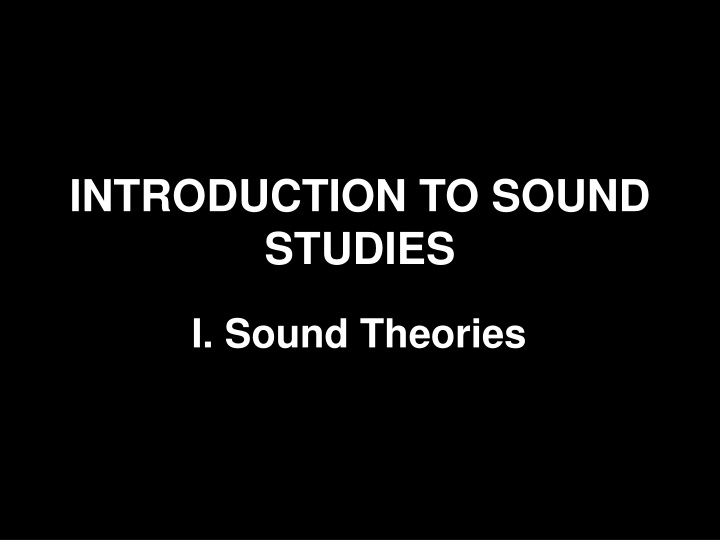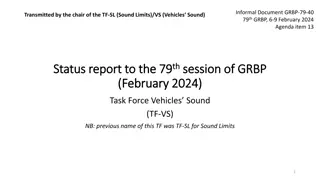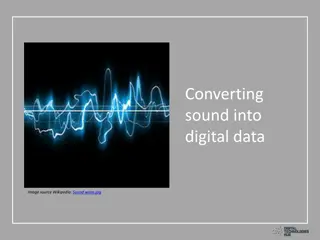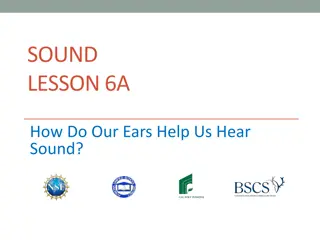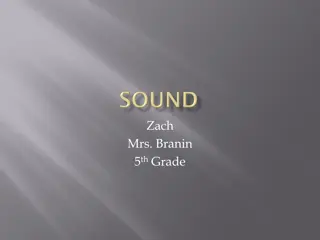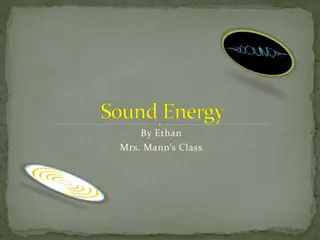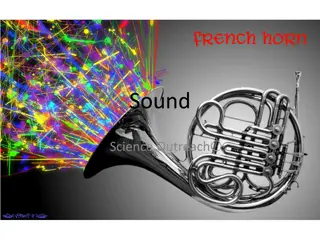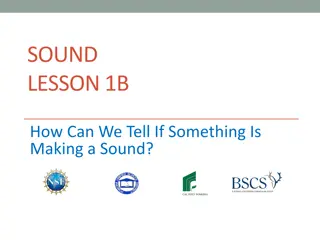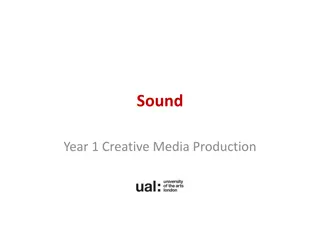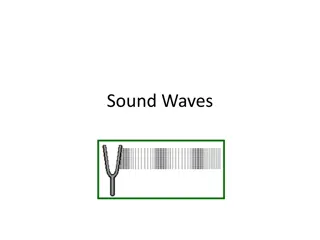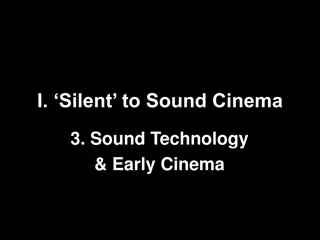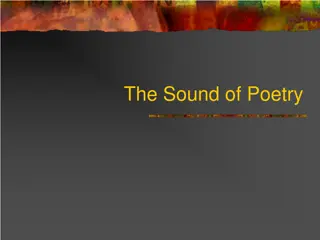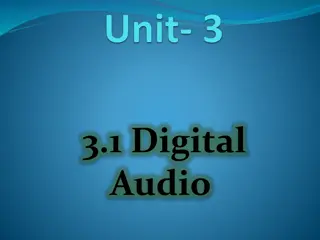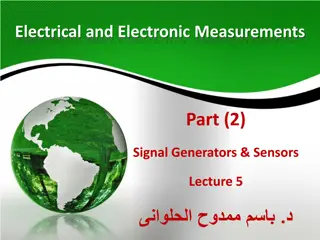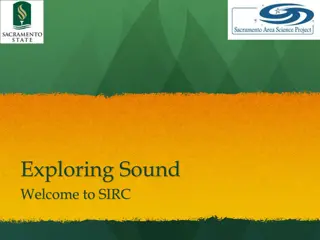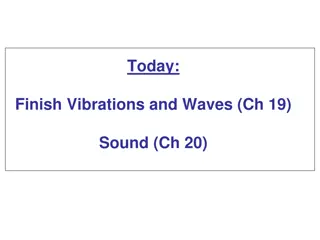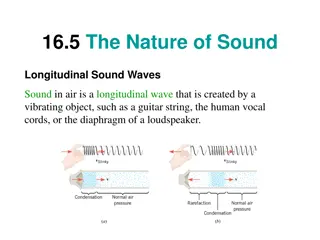INTRODUCTION TO SOUND STUDIES
This content delves into various sound theories, exploring listening, noise, voices, and the significance of sound in understanding the self. It examines theoretical models such as Phenomenology, Audio-Vision, and Ontology of Vibrational Forces, along with a case study on cassette sermons in Egypt. The focus lies on the phenomenological aspect of listening, deconstructing beliefs, and the interplay between the visible and invisible in auditory perception.
Download Presentation

Please find below an Image/Link to download the presentation.
The content on the website is provided AS IS for your information and personal use only. It may not be sold, licensed, or shared on other websites without obtaining consent from the author.If you encounter any issues during the download, it is possible that the publisher has removed the file from their server.
You are allowed to download the files provided on this website for personal or commercial use, subject to the condition that they are used lawfully. All files are the property of their respective owners.
The content on the website is provided AS IS for your information and personal use only. It may not be sold, licensed, or shared on other websites without obtaining consent from the author.
E N D
Presentation Transcript
INTRODUCTION TO SOUND STUDIES I. Sound Theories
1. Listening 2. Noise 3. Voices
to be listening will always, then, be to be straining toward or in approach of the self. (Jean Luc Nancy, quoted in Sterne, p. 19)
Listening explored through 3 theoretical models: 1. Phenomenology (Ihde) 2. Audio-Vision (Chion) 3. Ontology of Vibrational Forces (Goodman)
And a case study: 1. Cassette sermons in Egypt (Hirschkind)
Theoretical Model 1: Phenomenology Ihde asks: what is it to listen phenomenologically?
Theoretical Model 1: Phenomenology Ihde asks: what is it to listen phenomenologically? More than intense and concentrated attention to sound and listening
Theoretical Model 1: Phenomenology Ihde asks: what is it to listen phenomenologically? Awareness in the process of the pervasiveness of certain beliefs that intrude into attempts to listen to the things themselves .
Theoretical Model 1: Phenomenology Ihde asks: what is it to listen phenomenologically? The gradual deconstruction of those beliefs.
No matter how hard I look, I cannot see the wind, the invisible is the horizon of sight. An inquiry into the auditory is also an inquiry into the invisible. Listening makes the invisible present in a way similar to the presence of the mute in vision. (pp. 24-25)
The traditions of dominant visualism (pp. 25-26) 3 diagrams of auditory-visual perception the making of translating the invisible into the visible is a standard route for understanding the physics of sound. (p. 27) Allows sounds to be measured.
The movement from that which is heard (and unseen) to that which is seen raises the question of its counterpart. Does each event of the visible world offer the occasion, even ultimately from a sounding presence of mute objects, for silence to have a voice? Do all things, when fully experienced, also sound forth? (p.27)
The movement from that which is heard (and unseen) to that which is seen raises the question of its counterpart. Does each event of the visible world offer the occasion, even ultimately from a sounding presence of mute objects, for silence to have a voice? Do all things, when fully experienced, also sound forth? (p.27) Amplified listening
Theoretical Model 1: Phenomenology Ihde asks: what is it to listen phenomenologically? More than intense and concentrated attention to sound and listening
Theoretical Model 1: Phenomenology Ihde asks: what is it to listen phenomenologically? Awareness in the process of the pervasiveness of certain beliefs that intrude into attempts to listen to the things themselves .
Theoretical Model 1: Phenomenology Ihde asks: what is it to listen phenomenologically? The gradual deconstruction of those beliefs.
No matter how hard I look, I cannot see the wind, the invisible is the horizon of sight. An inquiry into the auditory is also an inquiry into the invisible. Listening makes the invisible present in a way similar to the presence if the mute in vision. (pp. 24-25)
The traditions of dominant visualism (pp. 25-26) 3 diagrams of auditory-visual perception the making of translating the invisible into the visible is a standard route for understanding the physics of sound. (p. 27) Allows sounds to be measured.
The movement from that which is heard (and unseen) to that which is seen raises the question of its counterpart. Does each event of the visible world offer the occasion, even ultimately from a sounding presence of mute objects, for silence to have a voice? Do all things, when fully experienced, also sound forth? (p.27)
Theoretical Model 2: Audio- Vision 3 Listening Modes: 1) causal, 2) semantic, 3) reduced Acousmatic listening How does film sound work?
in the present cultural state of things, sound more than image has the ability to saturate and short-circuit our perceptions. The consequence for film is that sound, much more than the image, can become an insidious means of affective and semantic manipulation. (p. 53)
in the present cultural state of things, sound more than image has the ability to saturate and short-circuit our perceptions. The consequence for film is that sound, much more than the image, can become an insidious means of affective and semantic manipulation. (p. 53)
Theoretical Model 3: Ontology of Vibrational Forces
Goodmans definition: An ontology of vibrational forces delves below a philosophy of sound and the physics of acoustics toward the basic process of entities affecting other entities. Sound is merely a thin slice, the vibration audible to humans or animals. Such an orientation should be differentiated from a phenomenology of sonic effects centered on the perceptions of a human subject, as a ready-made, interiorized human center of being and feeling.
Goodmans definition: An ontology of vibrational forces delves below a philosophy of sound and the physics of acoustics toward the basic process of entities affecting other entities. Sound is merely a thin slice, the vibration audible to humans or animals. Such an orientation should be differentiated from a phenomenology of sonic effects centered on the perceptions of a human subject, as a ready-made, interiorized human center of being and feeling.
While an ontology of vibrational force exceed a philosophy of sound, it can assume the temporary guise of a sonic philosophy, a sonic intervention into thought, deploying concepts the resonate strongest with sound / noise / music culture, and inserting them at weak spots in the history of Western philosophy, clinks in its character armor where its dualism has been bruised, its ocularcentrism blinded. (p. 70)
While an ontology of vibrational force exceed a philosophy of sound, it can assume the temporary guise of a sonic philosophy, a sonic intervention into thought, deploying concepts the resonate strongest with sound / noise / music culture, and inserting them at weak spots in the history of Western philosophy, clinks in its character armor where its dualism has been bruised, its ocularcentrism blinded. (p. 70)
What is an ontology? Sound comes to the rescue of thought rather than the inverse, forcing it to vibrate, loosening up its organized or petrified body. (p. 70) Goodman s objections to: 1) linguistic imperialism, 2) reductionist materialism, 3) phenomenological anthropocentrism
Vibration as a phenomenon and metaphor: Vibrating entities are always entities out of phase with themselves. (p. 71) A politics of frequency 3 disciplinary detours: 1) philosophy, 2) physics, 3) the aesthetics of digital sound
The sermons of well-known preachers spill into the street from loudspeakers in cafes, the shops of tailors and butchers, the workshops of mechanics and TV repairmen; they accompany passengers in taxis, minibuses, and most forms of public transportation; they resonate from behind the walls of apartment complexes, where men and women listen alone in the privacy of their homes after returning home from the factory, while doing housework, or together with acquaintances from schools or office, invited to hear the latest sermon from a favorite preacher. Outside most of the larger mosques, following Friday prayer, thriving tape markets are crowded with people looking for the latest sermon from one of Egypt s well- known Khutaba or a hard-to-find tape from one of Jordan s prominent mosque leaders. (p. 7)
Case Study: Islamic Cassette Sermons Commonly associated with the militants and radical preachers Bin Laden s Low-Tech Weapon A symbol of Islamic fanaticism The media form par excellence of Islamic fundamentalism The vast majority of taped sermons do not espouse a militant message
Listening to cassette sermons is a common and valued activity for millions ordinary Muslims around the world Political commentary directed against the nationalist project gives direction to a normative ethical project centered upon questions of social responsibility, pious comportment, and devotional practice. (p. 57)
Bears the imprint of popular entertainment media Three diverse strands are conjoined in these tapes: the political, the ethical, and the aesthetic. (p. 57)
Main Ideas and Research Questions: The practice of listening to such taped sermons - the colonialist / orientalist / modernist ocularcentric view of Muslim oratorical practices Evolving rhetoric style and performance in the tapes The formation of an Islamic counterpublic Islamic soundscapes
Modernity and the senses Part of a growing body of Anthropological literature focusing on the patterning of perception and sensory experience across different cultures and historical contexts
Comparative Analysis: Compare the cassette sermon listening practices of the Egyptian Muslims to one of your own listening practices, or one that you have studied in another class.
